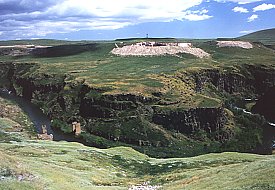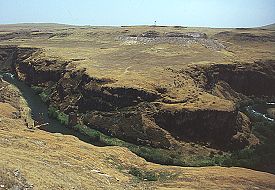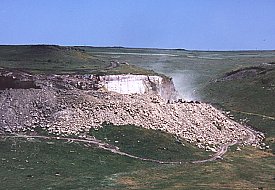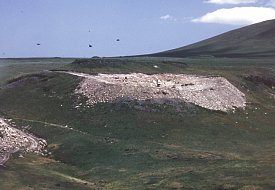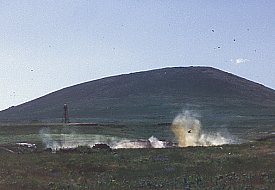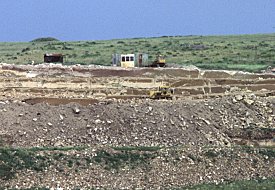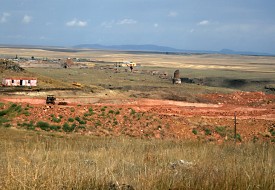Hurriyet, 8th May 2001
TALIBAN KAFASI
(They Act Like The Taliban)
The article's title is a reference to the destructon of Buhdist monuments in Afghanistan. The full article in Turkish can be read here. The following is an approximate English translation of its most important sections.
"At the border, near the Ani ruins, Armenia has made a stone quarry. Ani which is a protected site is in danger of collapse due to earth tremors because of the Armenian explosions. The Cathedral, dating from 967 and the Church of Tigran Honents, from 1215, have become cracked and masonry has started to fall down.
Ani is located near Kars on the border with Armenia, and it suffers from unpublicised Armenian aggression. Everyday the Armenians explode dynamite which causes artificial earthquakes. The Ani ruins, which date from the 9th and 10th century and which are near the Arpacay river, are cracking from hundreds of dynamite explosions. People from this region are angry because of the hundreds of explosions, and say that both they and Ani have to live with 3 to 5 earth tremors made by the Armenians everyday."
A later paragraph, under the subheading "It has been going on for 10 years", says:
"36 year old Mehmed Kara, from Ocakli village which is near the Ani ruins, has for the last 10 years lived with these dynamite explosions. He said that the Armenian stone quarry was formerly located 1km from Ani and they could see it from their village. Now it is much closer than before. "Three to five time a day we can hear the dynamite explosions. Not only us, but Esenkent village, 5km from here, and Arasoglu village, 4km from here, can also hear it". Sometimes the earth shakes. House windows rattle. All the family can feel it. Because of this dynamiting these historical monuments are being destroyed."
The article continues with a distorted version of Ani's history, then a fictional and overtly racist tale about an Armenian King of Ani, "Hairy Ohan", ravishing Muslim brides on their wedding night. Towards the end, under the sub-heading "A UNESCO Matter", the following is said:
"The Armenian stone quarry with its dynamite explosions should be stopped. On the 25.04.2001 UNESCO sent to the Turkish Ministry a petition in which they wanted to start reconstruction work. This have been done since 1995 by Baran Building Turizm Enterprise and Commercial Ltd., supervised by architect Mehmet Tuvel. The problem of the dynamite explosions and the destruction of Ani was brought up in a petition from May 1999. On 27.05.1999 the Ministry of Culture via the Ministry of Foreign Affairs again tried to solve this problem. A petition stated that from the start of the dynamite explosions till today the Cathedral, the Tigran Honents church (Boyali Kilise), the city-wall, and the Minuchihr Mosque have all been damaged."
Asbarez Online (www.asbarez.com), Yerevan, 15th May 2001
ARMENIA RESPONDS TO TURKISH ACCUSATIONS REGARDING DESTRUCTION OF RUINS OF ANI
An article published in the Turkish Hurriet newspaper on May 8 accused Armenia of deliberately destroying the ruins of Ani by means of explosions in the stone quarries near the Armenian-Turkish border. That article was part of the anti-Armenian hysteria raised in Turkey, Secretary General of the National Commission of Armenia for UNESCO Affairs to the Foreign Ministry of Armenia Varduhi Asaturian said. She further noted that blasting operations ceased a month ago.
A statement released by the Armenian foreign ministry, mentions a message that was sent by Turkey's permanent representative to UNESCO on December 18 of last year. Turkey filed a complaint with UNESCO, accusing Armenia of deliberately destroying the ruins of Ani by means of explosions in the mines located 600 meters from the Turkish border. The letter claimed that the explosions are causing damage to the Ani Cathedral, another church, and a mosque.
UNESCO forwarded the letter to the Armenian government, requesting a review of the matter. Foreign Minister Vartan Oskanian sent a letter to Industry and Trade Minister Karen Chshmaritian, requesting him to take appropriate measures.
The blasting operations were stopped in case damage was actually being caused to the medieval Armenian capital of Ani, which is treasured by all Armenians. Chshmaritian has stated that the mining will resume till May 31 so that the St. Gregory the Illuminator Cathedral in Yerevan can be completed.
The foreign ministry statement says Armenia understands and agrees with the concerns raised by Turkey. However, the Armenian side does not have the slightest intention of damaging the ruins of Ani. The fact that the Turks chose to apply to international bodies before approaching Armenia is an indication of Turkish efforts to politicize the issue, rather than deal with the actual problem of preserving the landmarks, says the statement.
The Turkish government's concern for historic Armenian landmarks located on its territory is inconsistent with the decades-long official Turkish state policy of intentionally destroying or converting these landmarks into Turkish monuments.
An article in the Turkish-Armenian magazine Agos in June 2001 mentioned the Ani quarry in passing.
The text says that the previous issue of the magazine contained an article on the quarry, however, I do not have a copy of it. The June 2001 article began with:
It is already seven years that the Turkish-language (with two pages in Armenian) Agos weekly is being published in Istanbul. In contrary to two Armenian-language dailies published in Istanbul - Jamanak and Marmara, Agos pursues a goal to somehow tie Istanbul-Armenians with those Armenians who don't speak Armenian. We met Agos editor-in-chief Hrant Dink in the editorial office of the newspaper.
At the very end of the story is the following:
Question: People say that Turkey also carried out a cultural genocide, hundreds of Armenian cultural monuments were destroyed in Turkey. Does Agos write about it?
Answer: Here is the last issue of our paper, where I wrote how Ani's walls were destroyed when quarries were being exploded in Armenia. Turkish press wrote about it. I wrote that "do Turks have a right to speak, did they make any effort for preserving any Armenian Church in their territory, didn't they close their eyes when the churches were turning into ruins?"
Tatoul Hagopian
Armenian International Magazine, June 2001
A small paragraph mentioning the quarry, the complaint to UNESCO, and Armenia's response to it, appeared on page 16 of the June 2001 issue of AIM. A photograph of the actual blasting accompanied the article.
The Armenian settlement of Ani Bemza sits just 150 yards across the Akhurian River from the ancient capital of Ani, just inside the Turkish border. In the ancient Armenian Ani, 1000-year-old churches stand in ruins, and are collapsing quickly, according to the Turkish government, which complained to UNESCO that Armenians were dynamiting stone quarries on the Armenian side, just so they could damage the ancient churches on the Turkish side. The Armenian Foreign Ministry wondered why Turkey had not expressed its concerns to Armenia directly. It had also said that all blasts would seize by May 31st. Ironically, Ejmiatsin is using the stones from the Ani quarries to complete the construction of the new St. Gregory Cathedral in Yerevan.
Anadolu Agency: News In English, 15th July 2001
TURKEY TO TAKE MEASURES TO PROTECT ANI RUINS
KARS - Environment Minister Fevzi Aytekin said on Saturday that Armenia was destroying the Ani Ruins on the Turkish Armenian border by exploding dynamites at the stone quarry close to the border and underlined that Turkey would take measures to stop the explosions.
Aytekin went to Digor township of the eastern province of Kars which recently suffered a flood and also visited Brigade Commander Cihangir Aksit and Kars Mayor Naif Alibeyoglu on Saturday.
Aytekin later visited the ancient city of Ani which is composed of historical ruins belonging to Turks, Georgians, Armenians and a number of other civilizations.
"Armenians are destroying these ruins which belong to the whole world by exploding dynamites at the stone quarry. I will discuss the matter with the Culture Minister as soon as I return to Ankara. The government will take certain measures to stop the explosions," he said.
Los Angeles Times, 30th August 2001
AS A RARE CATHEDRAL CRUMBLES, TWO RIVAL NATIONS POINT FINGERS: Turks blame Armenian quarry blasts for damaging church in Ani. The dispute is but one legacy of the countries' bloody, bitter history.
By Amberin Zaman
ANI, Turkey -- Towering above a bleak, wind-swept plateau near Turkey's border with Armenia, the red stone cathedral of Ani has defied wars, earthquakes and time.
But today, one of the holiest sites of Armenian Christian Orthodoxy is facing what an archeologist here calls the biggest threat of its millennium-old existence: dynamite blasts from four stone quarries less than a quarter of a mile away in Armenian territory.
The stone, ironically, is being mined to build a Christian Orthodox cathedral in Yerevan, the Armenian capital, that will look similar to the one in Ani. Turkish officials say the deafening explosions have shaken the area for two years despite their pleas to Armenia for the quarrying to stop. The United States, France and the United Nations have backed Turkey's appeal.
"Not only the cathedral but most of the monuments here will soon collapse," said Beyhan Karamaragli, a Turkish archeologist who has been leading excavations here since 1988. "This is cultural genocide."
Genocide is a particularly loaded word here. Armenians often use it to describe how they say the Ottoman Turks killed 1.5 million Armenians during World War I. Turkish officials today acknowledge that as many as 600,000 Armenians died but portray them as victims of civil disorders, exposure and starvation as they fled southward to escape the conflict.
The dispute over those deaths still stands in the way of diplomatic and trade relations between Armenia and Turkey, as does Armenia's continued occupation of territory claimed by Turkey's closest regional ally, Azerbaijan.
Gagik Gurjan, head of the cultural heritage department of the Armenian Culture Ministry, said geologists at the quarries had been consulted and that they had reported that the quarrying of stone there could not be damaging the cathedral in Ani.
"I think some people in Turkey are using this situation for political ends," he said. "If the Turks hadn't destroyed these monuments themselves over the centuries, they would have nothing to complain about now."
"What's more," he added, "there is a gorge between them, and the shock waves from the explosions could not reach or in any way affect any building or monument in Ani."
Trying to break the ice, retired diplomats and academics from Turkey and Armenia have set up a commission to promote cooperation in educational and cultural projects. At their first meeting last month, in Geneva, they reportedly discussed a joint effort to preserve the ruins of this walled medieval town.
Until the early decades of the 20th century, at least 2 million Armenians are believed to have lived in Turkey, mostly in the east. Today, about 60,000 Armenians remain in Turkey; most of them live in Istanbul.
Nowhere are traces of the Anatolia region's Armenian heritage more visible than in Ani, 27 miles northeast of the Turkish town of Kars.
Ani rises above the emerald green waters of the Arpa River, which separates Turkey from Armenia. Stubby pillars that once supported a 14th century stone bridge between the two countries remain as a symbol of the neighbors' stormy ties.
Armenians and Turks tell different versions of Ani's history.
Turkish historians insist that Ani holds greater significance for Turkey because it was one of the first Anatolian cities to be conquered by the Seljuk Turks when they swept in from Central Asia in the early 11th century. Armenian rule, they say, did not last more than 50 to 70 years before defeat by the Seljuks.
According to Armenian accounts, Ani was ruled for much of its history by a succession of Armenian kings, and it was their capital for at least two centuries. In the 10th century, Ani was glorified by the Armenians as "the city of a thousand and one churches," with the cathedral as its centerpiece.
"If so, why are they [Armenians] willfully destroying it now?" asked Karamaragli, pointing to a 30-foot-long crack in the southwest corner of the cathedral, which she says widens with the tremors from the quarries.
The septuagenarian archeologist says she has records of every blast and every crack and hole resulting from each explosion. The nearby Menucehr, the oldest Seljuk mosque in the region, has suffered some of the worst damage.
In this earthquake-weary country, residents of the neighboring village of Ocakli often mistake the tremors for quakes. "Our children are terrorized. Our cows have stopped producing milk," said Muhammad Sevcan, a local farmer.
In an embarrassment for the Armenian government, an ear-splitting explosion rocked the site in mid-June just as a group of Armenian Americans had gathered to pray at the cathedral. They were part of a 150-member group of Armenian Americans on a pilgrimage through Turkey to retrace the steps of St. Gregory. "They were terrified--they thought it was a bomb," recalled Mehmet Kinacioglu, a Turkish tourist who was present. Pilgrims reportedly sent letters of complaint to the Armenian government. So did the Istanbul-based Armenian patriarch, Mesrob II. No explosions have been heard here since mid-July.
(NB: the above story is false. It originated in a Turkish newspaper several days after the pilgrimage event. No explosions took place during the two hours that the Armenians spent at Ani.)
Turkish officials, though, say they doubt that the respite will last long. They point to a May 5 report from Russia's Interfax news agency quoting an Armenian Foreign Ministry spokesman as saying the quarrying would stop by the end of that month. "In June, the explosions were continuing," said a senior Turkish diplomat, "so who is to say they will not resume again?" Gurjan, the Armenian official, said the blasts have stopped. But it wasn't because of complaints from Turkey, he said, but because workers are now using different quarrying methods.
* Staff writer Robyn Dixon in The Times' Moscow Bureau contributed to
this report.
|  |
Interfax News Agency, Yerevan, 12th May 2001
ARMENIA AGREES TO HALT BLASTING OPERATIONS THREATENING MONUMENTS IN TURKEY
Armenia has agreed to abide by UNESCO recommendations and halt blasting operations in a stone pit on the border with Turkey.
Earlier, Turkey lodged a request with UNESCO to urge Armenia to halt these blasts.
The Armenian Foreign Ministry has told Interfax, quoting the request, that the demolition endangers historical monuments in the old Armenian town of Ani situated on the territory of contemporary Turkey.
A ministry spokesman warned Turkey "not to speculate on such issues any longer by sending letters to international organizations, but to get in touch directly with Yerevan instead."
"We, for our part, will do all we can to preserve these monuments, since it is in our interest to do so," the spokesman added.
Snark News Agency, Yerevan, 15th May 2001
HISTORICAL MONUMENTS OF ANI ENDANGERED BECAUSE OF CONSTRUCTION OF ST. GRIKOR CATHEDRAL
The blasting operations in quarries on the Armeno-Turkish border, endangering the historical monuments of the ancient Armenian capital, Ani (in the territory of modern Turkey), can't be stopped till the end of the month, the head of the UNESCO department of the foreign ministry, Vardui Asatouryun, told SNARK, referring to the ministry of industry and trade of Armenia, Karen Tchshmarityan.
The works should be continued as materials are needed for the construction of the St Grikor Lusavorich Cathedral in Yerevan.
Earlier, the Turkish authorities asked the UNESCO to pressure Armenia into stopping the blasting operations over the section.
UNESCO re-sent the message to the foreign ministry of Armenia, which agreed with Turkey on the matter. But the industry and trade ministry of Armenia "giving an understanding to the problem" said it has to continue the works.
Armenpress, Yerevan, 16th May 2001
THE CITY OF ANI TOO DEAR TO ARMENIANS
The Turkish Hurriyet daily has recently expressed some concerns over the explosions, carried out by Armenia in stone quarries located on the other side of the border. The Turkish paper claimed the explosions were damaging the mediaeval city of Ani, which was by the way the capital of the Armenian kingdom of Bagratuni.
The Armenian press has also commented on these explosions providing some explanations. In response to these rumors the Armenian foreign affairs ministry's UNESCO department spread an announcement, which runs as follows: "The Turkish permanent representative in UNESCO sent a letter of complaints to the UNESCO deputy head of culture issues, expressing protest against the explosions realized in Armenia at a distance of 600 meters from the city of Ani. The letter claimed that the explosions were damaging the churches and a mosque in Ani. A duplicate of the letter was sent by the UNESCO leadership to the Armenian foreign affairs ministry, asking to discuss the issue. Armenia's foreign minister Vartan Oskanian addressed the trade and industry minister Karen Chshmaritian asking to stop explosions, stressing the importance of the Armenian medieval capital for all the Armenians.
In response to Vartan Oskanian's letter, Mr. Chshmariatian said that the explosions will continue till May 31 to provide stones for the construction of Gregory the Illuminator Cathedral in Yerevan". Accepting the protest of the Turkish side, the UNESCO department of the ministry of foreign affairs announced that Armenia has never meant to damage Ani, the unique Armenian cultural monument. The Armenian side is also displeased with the fact that Turkey addressed international structures instead of addressing Armenia directly.
GAMK (French-Armenian magazine), 17th May 2001
LE MONDE À L'ENVERS...
Après avoir, des décennies durant, laissé se dégrader le site d'Ani, accélérant même parfois à coup de canons, les ravages du temps, la Turquie accuse aujourd'hui l'Arménie d'endommager les ruines de la capitale médiévale arménienne, dont on a célébré le millénaire, notamment par une exposition à Paris!
Un article paru dans l'édition du 8 mai du journal turc Hurriyet accuse ainsi l'Arménie de détruire délibérément les ruines d'Ani en déclenchant des explosions dans les carrières de pierre à quelques centaines de mètres du site archéologique, du côté arménien de la frontière, marquée par le fleuve Akhourian. Le représentant permanent de la Turquie à l'UNESCO aurait envoyé un message à ce sujet le 18 décembre 2000 à la direction de l'agence onusienne chargée de la protection du patrimoine mondial, l'avisant des dommages causés par ces explosions délibérées à la célèbre cathédrale d'Ani, à une autre église, et à une mosquée. L'UNESCO avait alors fait part de ce courrier aux autorités arméniennes en demandant des explications à ce sujet, rapporte le ministère arménien des affaires étrangères qui s'est emparé de l'affaire. A la suite de quoi, le ministre arménien des affaires étrangères Vartan Oskanian a adressé une lettre au ministre arménien de l'industrie et du commerce Karen Chchmaritian, lui demandant de prendre des mesures s'il y a lieu. Le ministre répondra que les explosions, qui on d'ailleurs cessé depuis un mois, pourraient se poursuivre jusqu'au 31 mai prochain, les pierres servant à la construction de la nouvelle cathédrale Saint Grégoire l'illuminateur à l'occasion du jubilé du 1700e anniversaire de la conversion de l'Arménie au christianisme, étant extraites de cette carrière. Le gouvernement arménien a bien sûr ajouté que l'Arménie n'avait aucunement l'intention d'endommager le site d'Ani, dont elle lutte au contraire pour la préservation, délibérément négligée par les gouvernements turcs successifs. Il constate que le fait que la Turquie ait sollicité l'UNESCO dans cette affaire sans aviser directement l'Arménie témoignait de sa volonté de politiser la question.
G.ULUBEYAN
Turkish Daily News, 10th July 2001
ARMENIANS DESTROYING TURKISH SITES: STONE QUARRIES THREATEN ANI RUINS IN KARS
The "Turkish Daily News" is an English-language newspaper published in Ankara, Turkey.
Ankara University Armenian Turk Relations Investigation Center manager assistant professor Erol Kurkcuoglu said, "UNESCO and all of the world environmental organizations must pay attention to the Armenian's behaviour." Dynamite used in stone quarries in Armenia are causing harm to the ruins of Ani and other historical locations in Kars. Georgian, Armenian and Turkish historical treasures and many others on the Turkish-Armenian border are being harmed by the stone quarries which opened between 2000-2001 just 100 meters away from the border.
Kurkcuoglu said the Armenian's attitude shows that they are not considering the possibility of destroying historical treasures. UNESCO has to take this attitude into account and launch an initiative to stop the operation of these quarries, he added.
The aim of the Armenian's seems to be to put Turkey into difficult situations in the future. Following this destruction, Turkey will be accused of misinterpreting the Armenian's actions in the international arena, as they did with the so-called genocide. They are expert at accusing Turkey for everything they did, said Kurkcuoglu. Would there be the same silence if Turkey had done it? Ataturk University's science and literature faculty history department chair professor Enver Konukcu said that if Turkey had done it in such a close area to the historical treasures, it would alarm the whole world. These treasures do not just belong to the Turkish people, they should also be saved by other nations.
A Letter Submitted To UNESCO On The 31st July 2001
First, please allow me to use this opportunity to remind you that several times during recent years, the Armenian national Commission of UNESCO and other governmental bodies have tried to establish contact with relevant Turkish bodies and suggested plans for the joint study and preservation of the city of Ani. Because of the great historical and cultural importance of this monument for Armenia, Armenia was ready to provide such expeditions with the necessary technical expertise and financial support. Unfortunately, each and every time the Turkish side has responded with references to the difficulties in relation between our two countries.
I am aware that even in Turkey there is no common view held by different institutions and the Government concerning Armenias cultural heritage on the territory of present-day Turkey. Last year, we received information that the Turkish committee of ICOMOS, while preparing the tentative list of for the WHL (World Heritage List) presented, among other sites, the same city of Ani, capital of medieval Armenia, as well as the Monastery of Akhtamar, located on the island of Lake Van. Regretfully, the Turkish Ministry of Culture deleted these two sites from the tentative list.
With regards to explosions in quarries within Armenian territory (which have already ceased) and which have reportedly damaged historical monuments, I must note that, first, for obvious reasons, Armenian specialists cannot witness the situation on the Turkish side of the border. Secondly, Armenian seismic experts explain that explosions of such magnitude cannot affect any construction at a distance of 600m.
Finally, once again, I regret that our Turkish colleagues did not find it possible to contact the relevant bodies in Armenia directly, rather than to apply to international organizations.
To this end, let me express my hope that the International Conference on Implementation of UNESCO Cultural Conventions and Other International Instruments, which will be held in Yerevan on September 17-18, 2001, and to which Turkish governmental representatives have been invited, might be a proper forum for the discussion of this particular matter.
Vartan Oskanian
Chairman of Armenian National Commission for UNESCO
Asbarez Online (www.asbarez.com), 31st August 2001
LA TIMES DISTORTS TRUTH ABOUT ANI
LOS ANGELES. In an article in the Thursday edition of the Los Angeles Times, entitled "As a Rare Cathedral Crumbles, Two Rival Nations Point Fingers" the author Amberin Zaman, a special correspondent to the Times, discusses a new controversy surrounding the ancient Armenian city of Ani.
The article, filled with distortions and peppered with Turkish accounts of the actual events, reads more like a press release for the Turkish government, than an objective report, using journalistic standards.
The article focuses on alleged damage to the ancient ruins caused by dynamite blasts from four quarries in Armenia.
Several months ago, a war of words ensured between the Turkish and Armenian governments and now the article claims that the Turkish government is concerned about the fate of the ancient. "Turkish officials say the deafening explosions have shaken the area for two years despite their pleas to Armenia for the quarrying to stop. The United States, France and the United Nations have backed Turkey's appeal," reported the LA Times.
"Not only the cathedral but most of the monuments here will soon collapse," Beyhan Karamaragli, a Turkish archeologist told Zaman, adding "This is cultural genocide."
The author then discusses the Armenian Genocide, as a contentious issue between Armenians and Turks, without even a mention that the Turkish government is responsible for the state of disarray of not only Ani, but countless other Armenian churches and monuments, which it is systematically destroying as a continuation of its campaign of genocide.
Gagik Gurjan, head of the cultural heritage department of the Armenian Culture Ministry, told the LA Times that "geologists at the quarries had been consulted and that they had reported that the quarrying of stone there could not be damaging the cathedral in Ani."
"I think some people in Turkey are using this situation for political ends," he told the Times. "If the Turks hadn't destroyed these monuments themselves over the centuries, they would have nothing to complain about now." "What's more," he explained to Zaman, "there is a gorge between them, and the shock waves from the explosions could not reach or in any way affect any building or monument in Ani."
"Turkish historians insist that Ani holds greater significance for Turkey because it was one of the first Anatolian cities to be conquered by the Seljuk Turks when they swept in from Central Asia in the early 11th century. Armenian rule, they say, did not last more than 50 to 70 years before defeat by the Seljuks," reported Zaman for the LA Times.
http://www.turkishdenial.com
GENOCIDE DENIAL EXAMPLE 4: PURE FICTION
This, unfortunately, is not an untypical example of the response from the Armenian diaspora to the reports about the quarry. The author of the following has the cheek to cite, several times, pages from VirtualAni on his website!
LA Times, Thursday, August 30, 2001: journalist Amberin Zaman made up key elements of a story about ancient Armenian churches across historic Armenia - a place she calls Eastern Turkey. She reported dangerously fictional disinformation, claiming that mining explosions dozens of miles away from the churches-- explosions in (what is left of) Armenia-- were somehow causing the churches across the border in Turkey to fall apart! It is cultural genocide, she writes, purportedly quoting a Turk.
Thus, the reality of the Armenian Genocide and Turkeys architectural thievery of ancient Armenian Churches - thousands of them, vandalized, pulverized, partly destroyed or left to rot in Turkey - is miraculously turned into a "cultural genocide" blamed on no less than today's Armenians, located miles across the border! Her article also contains a completely fictional reference to Armenian Americans who were purportedly visiting an Armenian church in "Eastern Turkey" and were "frightened" by the tremors from the explosions. That event NEVER OCCURRED!
Amberin is artful, yes - but big time liar.
Thus, the Los Angeles Times published FICTION written by an organ of Turkeys Industry of Genocide Denial, Miss Amberin Zaman.
|
